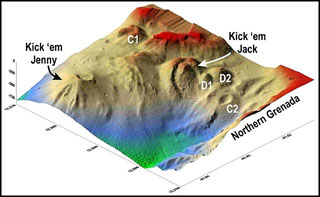Report on Kick 'em Jenny (Grenada) — 22 July-28 July 2015
Smithsonian Institution / US Geological Survey
Weekly Volcanic Activity Report, 22 July-28 July 2015
Managing Editor: Sally Sennert.
Please cite this report as:
Global Volcanism Program, 2015. Report on Kick 'em Jenny (Grenada) (Sennert, S, ed.). Weekly Volcanic Activity Report, 22 July-28 July 2015. Smithsonian Institution and US Geological Survey.
Kick 'em Jenny
Grenada
12.3°N, 61.64°W; summit elev. -185 m
All times are local (unless otherwise noted)
The University of the West Indies (UWI) Seismic Research Centre (SRC) reported that seismic activity at Kick 'em Jenny had increased on 11 July. Another increase occurred on 23 July from 0125 to 0300, characterized by a "strong continuous signal." More than 400 micro and small earthquakes had been recorded since 11 July; the largest event was M 3.3. The Alert Level was raised to Orange (the second highest level on a 5-color scale) on 23 July.
At about 0200 on 24 July an hour-long explosion signal was recorded. Afterward, and through the next day, seismicity declined. The report encouraged mariners to observe an exclusion zone with a 5-km radius of the crater. Scientists observed nothing out of the ordinary at the surface above the volcano during an overflight on 25 July, and by 1800 no activity was recorded. On 26 July the Alert Level was lowered to Yellow.
Geological Summary. Kick 'em Jenny, an active submarine volcano 8 km off the N shore of Grenada, rises 1,300 m from the sea floor. Recent bathymetric surveys have shown evidence for a major arcuate collapse structure, which was the source of a submarine debris avalanche that traveled more than 15 km W. Bathymetry also revealed another submarine cone to the SE, Kick 'em Jack, and submarine lava domes to its S. These and subaerial tuff rings and lava flows at Ile de Caille and other nearby islands may represent a single large volcanic complex. Numerous eruptions have occurred since 1939, mostly documented by acoustic signals. Prior to the 1939 eruption, when an eruption cloud rose 275 m above the ocean and was witnessed by a large number of people in northern Grenada, there had been no written mention of the volcano. Eruptions have involved both explosive activity and the quiet extrusion of lava flows and lava domes in the summit crater; deep rumbling noises have sometimes been heard onshore. Recent eruptions have modified the morphology of the summit crater.
Source: University of the West Indies Seismic Research Centre (UWI-SRC)

